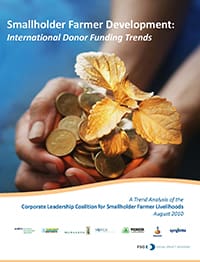Smallholder farmers represent one of the world’s most critical development opportunities, and private sector actors, in partnership with each other and international donors and local governments, have an important role to play in the development of these farmers. This first-of-its-kind snapshot analyzes the state of smallholder funding trends, profiles key geographies, and identifies potential partners to help actors across sectors understand and capture the many opportunities still available in smallholder development.
Top Takeaways
- Across the 1,767 projects analyzed, funding for smallholder farmers amounted to $12 billion for the period from 2009 and onward $2.6 billion for 2009 alone (comprising approximately 2% of 2009 development aid).
- Smallholder funding is relatively evenly distributed across the three broad areas of infrastructure/environment, finance/markets, and inputs/training; funding comes predominantly from multilateral development agencies; and geographically, Africa receives the greatest share of funding among all continents, though the individual countries receiving the greatest funding flows are in Asia.
- Among the countries receiving the greatest smallholder funding are India, Tanzania, Ethiopia, Ghana, and Indonesia, with significant opportunities to increase productivity, expand crop diversification, improve market access, invest in irrigated agriculture and agriculture water development, reduce land degradation, regulate land ownership, and provide technical assistance.


